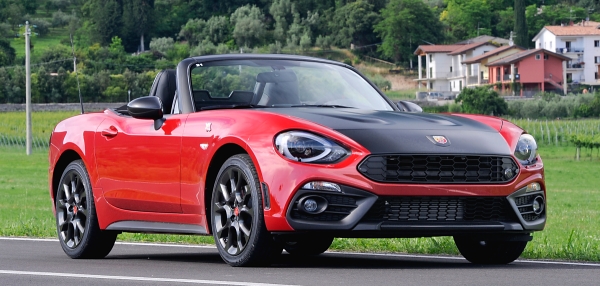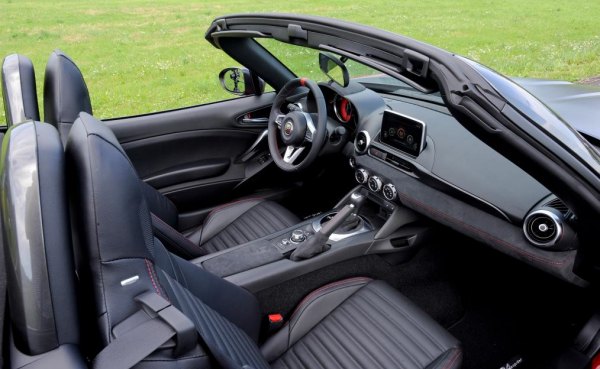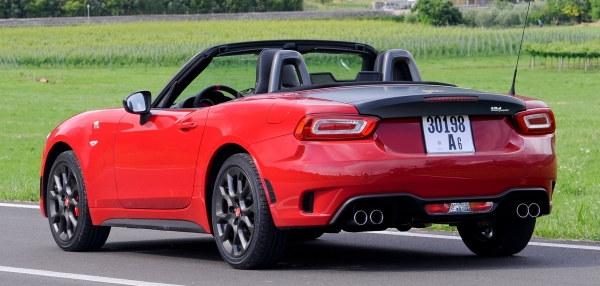|
|
|
| Published
on 14
Jun
2016 |
All rights reserved.
|
|
|
About 3 years ago,
Mazda signed a surprising contract with Fiat Chrysler, offering its
jewel of the crown, MX-5, as the basis for a new Alfa Romeo Spider.
Mazda needs the additional sales volume to make the MX-5 project
profitable and keep the factory busy once the initial interests for its
own car fades out. Fiat Chrysler, on the other hand, needs a halo car –
more relevant to its target customers than the low-volume 4C – to fuel
the revival plan of Alfa. However, the Italian changed their minds just
as quick as sports car goes. It was soon decided that the car to wear
the Fiat badge, accompanied with a higher performance derivative with
Abarth logo. As United States will be its biggest market, what else
could be better than reusing the historic name 124 Spider? Yes, 124 Spider was very popular in the
America during the 1960s and 70s. As many as 3-quarters of the 200,000
units were sold there. While Alfa
Spider was movie star, it was the 124 Spider that sold in huge
volume, cementing the popularity of Italian roadsters. Ironically, it
was the first Mazda MX-5 that finally took over the market left by the
124 Spider.
Make no mistake, the 124 Spider is built in Hiroshima together with
MX-5 using mostly the same underpinnings, but it is not a simple
badge-engineering. Fiat offered its own engine and retuned its chassis
to
inject a different character. It also redid the exterior styling
comprehensively by its Centro Stile in Turin. Yes, it is supposed to
offer the best of both worlds: Italian styling and Japanese build
quality! Bravo!
Unfortunately, the result is wide of the mark. Perhaps it tries too
hard
to resemble the original 124 Spider, the new car looks too retro to be
inspiring. While the Mazda is sleek and sharp, the Fiat is dull and
odd. If it resembled the perfect proportion of the original
classic, it would have been called a beauty perhaps. Unfortunately, the
guys at Centro Stile forgot that the MX-5 platform has a
front-mid-engined layout. The unusually long distance between its front
axle and cockpit can be packaged in style only with exaggerating curves
– see the classic Ferrari 250GTO, Toyota 2000GT or modern TVRs. Any
attempts to use straight lines and flat surfaces to cover the long
engine compartment would result in disastrous effect. Consequently, the
new 124 Spider has a bonnet appearing to be endless long, plain and
dull. The cockpit looks too rearward and the windscreen looks too
upright, even though it is actually the same as the Mazda's. Apart from
wrong
proportion, the design details are no better. Those
characterless taillights have no coherence with the organic headlights.
And the trunk lid looks as if added as an afterthought! Some said the
car looks better in the real world than in photos, but most agree that
it is not a beautiful sports car.
On the plus side, the interior is quite successful, because 95 percent
of it is carried over from the Mazda, which is not surprising because
interior is always expensive to engineer. It succeeds the Mazda’s good
ergonomics, a snug but not cramped environment, good seats, an
excellent manual hood and up-to-date infotainment system. If anything,
it is even better finished. For example, some of the cheap plastics
have been replaced with soft-touch ones, and some are covered with
expensive-looking leather trims. The restyle door panels also look more
matured than the body-colored ones in Mazda. Fiat also specified a
laminated windscreen, more sound deadening materials and a thicker
fabric roof to cut noise level in the cabin. You can have normal
conversion with your passenger when travelling at 80 mph on highway.
Try this on the Mazda! At the back, the longer
tail of Fiat affords a 10-liter larger luggage space.
Sheet metal aside, the chassis is basically identical to MX-5. It is
made of mainly high-strength steel and a few aluminum parts – such as
parts of crash structure, subframe, bulkhead, bonnet and boot lid. The
longer front and rear overhangs necessitated by the restyling adds 140
mm to the overall length. In addition to a heavier (iron-block &
turbocharged) engine and the aforementioned insulation enhancement, the
whole car carries an extra 50-75 kg, depending on which MX-5 model you
compare with. That said, 1050 kg is still pretty lightweight for a
roadster.
Power comes from Fiat’s 1.4 Multiair turbo, which is shipped from Italy
to Japan to mate with the rest of the car. This motor is good for 170
hp in Alfa Romeo Giulietta from the very beginning, but Fiat
deliberately detuned it to 140 hp in this application (170 hp tune is
reserved for Abarth version, see below). Still, with a maximum torque
of 177 lbft available from 2500 rpm, it gives a very different
character compared with Mazda’s high-revving Skyactiv-G engines. While
the latter begs you to rev it beyond 7000 rpm, the Multiair turbo is
content to spend its whole life at the mid-range. It offers plenty of
torque hence flexibility once you have overcome its turbo lag, which is
quite noticeable below 2500 rpm. This means, if you keep it above 2500
rpm, it offers an easier, quieter and more laid-back driving
experience. In other words, it suits older, lazier drivers. Young
drivers would always prefer the Mazda’s quick throttle response, linear
delivery and livelier character, as well as the opportunity to use its
slick-shifting gearbox to the full. The Fiat is no slower in the real
world though. It takes 7 seconds to go from rest to 60 mph, faster than
the 1.5-liter MX-5 actually. US version has a more powerful, 160 hp /
184 lbft tune (same as the US-market 500 Abarth) thus it is about as
quick as the 2.0-liter Mazda.
However, its power tail off quickly beyond 5500 rpm, thus you had
better to upshift early. Such reluctance to rev is especially
disappointing for an Italian roadster – luckily it happens to be a Fiat
instead of Alfa! The too-quiet sound of the Multiair turbo is also too
matured to this kind of cars.
Such a maturity is consistent with its handling. Fiat retuned its
springs, dampers and anti-roll bars to give the car more resistance to
body roll, unlike Mazda which deliberately lets a lot of old-fashioned
body roll to enrich driver
feedback. It is still a relatively soft setup compared with the usual
German machines though. Its steering is tuned heavier, calmer on
turn-in and requires less correction when cruising on highway. On the
flipside, this means the car is not quite as enthusiastic to change
direction as the
Mazda. The inherent chassis balance remains good, but it is more
difficult to oversteer on throttle. At the limit, the lack of LSD hurts
its
cornering prowess a little, so you cannot drive it as hard as a
properly equipped MX-5 in tight corners. Ride comfort also suffers a
little as a result of the stiffer suspension. Sharp
low-speed bumps could catch it out and result in some noticeable body
shudders. Overall, the chassis setup might please less committed
drivers.
With a sibling as vibrant as Mazda MX-5, Fiat is wise to adopt a
different strategy. It made the 124 Spider a more matured roadster –
quieter, better finished, more practical and more effortless to drive,
yet with the fine underpinnings of MX-5 it is never boring to drive.
Well, the 1.4 Multiair engine is a little bit let down, as it is more
suitable to small family cars than a sports car. The retro exterior
design is also quite disappointing. Still, it is different enough to
attract different kind of customers. It is a win-win partnership
between Fiat and Mazda.
|
Verdict:     |
Published
on 14
Jun 2016
|
All rights reserved.
|
|
Abarth 124 Spider
|
|

|
While the regular 124
Spider is deliberately made civilized to avoid direct clash with Mazda,
the Abarth version is serious enough to give Mazda a good fight. Its
engine remains that 1.4 Multiair, but it is in the full 170 hp tune*,
enabling 0-60 mph to be accomplished in 6.5 seconds and claiming a top
speed of 144 mph (the latter is probably too optimistic to me though).
It gets a mechanical LSD as standard, as well as sportier Bilstein
dampers (like Mazda), stiffer springs / anti-roll bars, lower ride
height, Brembo front brakes, grippier tires and a louder quad-exhaust
system. The chassis is reinforced with a front tower brace. Outside,
its aluminum bonnet and trunk lid are painted matt black to resemble
the original Abarth 124 rally
car. Whether you like its styling is a matter of taste.
* US version of
the car gets only 4 extra horsepower from the base 160 hp thanks to the
freer flowing exhaust. It seems that Fiat wants to save certification
cost, thus all its US-market 1.4 Multiair engines are rated the same.
The interior is suitably upgraded with Alcantara trims and more
supportive, part-leather part-Alcantara seats. It looks and feels more
delicious than the top MX-5. However, at £30K the Abarth 124
Spider is also a lot more expensive. In fact, it has elevated into a
class above, facing stronger opponents like Lotus Elise and Audi TT
Roadster.

|
On the road, the turbo engine still displays more lag than
desired at lower revs, but up the pace to 3000 rpm and it feels
noticeably stronger than either the base engine or Mazda’s naturally
aspirated 2-liter, thanks to 184 pound-foot of torque. It is also more
eager to visit the 6500 rpm redline than the 140 hp version. Meanwhile,
the quad-exhaust emits a loud, sporty growl. It sounds quite exciting.
The short-throw gearchange and accurate clutch work perfectly with the
engine. The LSD offers good traction for the car to attack tight
corners. The extra heft of the retuned steering is precise and
reassuring. The stiffer chassis and reduced body roll give you more
confidence to maneuver. Undoubtedly, this is a more serious machine
than the Mazda, which is more about feel and balance. However, it is
not overly firm like Audi TT. In fact, more like Lotus Elise, the
suspension damping is supple enough to deal with mountain roads, while
it lets enough roll to make you feel connected to the car. The balance
is just as great as MX-5. No, perhaps even better. With added mid-range
thrust, you can drift the car more readily than its chassis donor. Its
tail breaks away progressively, so you can manage the drift in slow
motion. From this view point, it sets a new standard for an affordable,
practical roadster. More interesting to drive than Audi TT, let alone
the numb BMW Z4 or Mercedes SLC.

|
Unlike Lotus Elise, the Abarth Spider fails to transform its excellent
road manner to race tracks. There is simply too much roll and softness
in its suspension to keep you from extracting the most from its
chassis, which is admittedly not rigid enough for the task. The MX-5
chassis was designed for lightweight in the first place, so it was not
supposed to take on too much power or track abuse. Some people, like
those in Evo, do not understand this thus keep complaining both the
Abarth and Mazda. However, use the car purely on road, especially an
unknown mountain road, you can have huge fun.
|
Verdict:     |
|
|
|
|
|
|
|
|
|
|
Fiat 124 Spider
|
2016
|
| Front-engined,
RWD |
| Steel monocoque |
Steel + aluminum
|
| 4054 / 1740 / 1233 mm |
| 2310 mm |
Inline-4
|
| 1368 cc |
SOHC 16 valves, VVT+VVL
|
| Turbo |
| - |
140 hp / 5000 rpm (EU)
160 hp / 5500 rpm (US)
|
177 lbft / 2250 rpm (EU)
184 lbft / 2500 rpm (US)
|
6-spd manual (6-spd auto)
|
F: double-wishbones
R: multi-link
|
| - |
| 205/45R17 |
1050 kg
|
| EU: 133 mph (c) |
EU: 7.1 (c)
US: 6.8 (c) / 6.3* (6.8*)
|
US: 16.9* (19.1*)
|
|
Abarth 124 Spider
|
2016
|
| Front-engined,
RWD |
| Steel monocoque |
Steel + aluminum
|
| 4054 / 1740 / 1233 mm |
| 2310 mm |
Inline-4
|
| 1368 cc |
SOHC 16 valves, VVT+VVL
|
| Turbo |
| - |
170 hp / 5000 rpm (EU)
164 hp / 5500 rpm (US)
|
184 lbft / 2500 rpm
|
6-speed manual
|
F: double-wishbones
R: multi-link
|
| - |
| 205/45WR17 |
1060 kg
|
| EU: 144 mph (c) |
EU: 6.5 (c)
US: 6.8 (c) / 6.7* / 6.5**
|
US: 18.8* / 17.6**
|
|
|
|
|
|
|
Performance
tested by: *C&D, **MT
|
|
|
|
|
|
|
|
|
Copyright©
1997-2016
by Mark Wan @ AutoZine
|
|